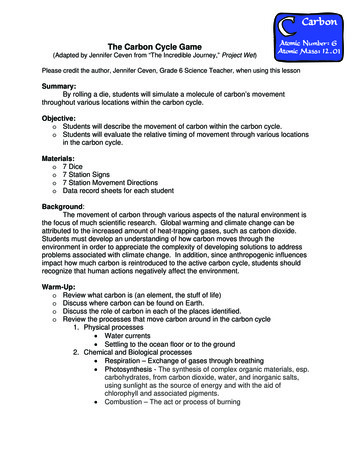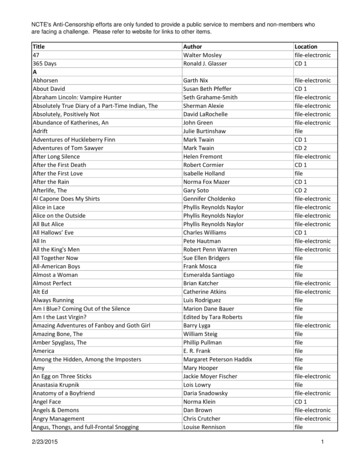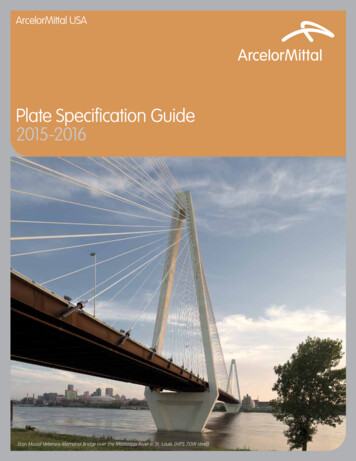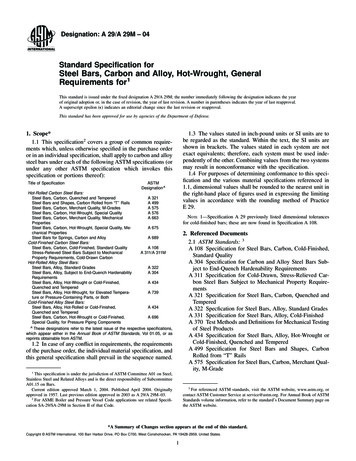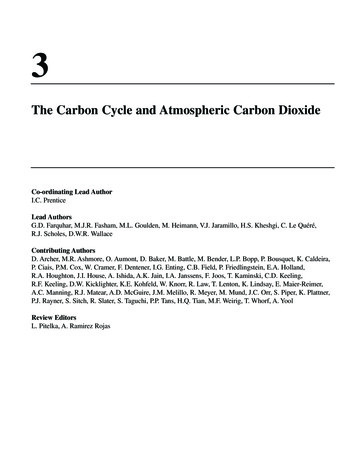
Transcription
Submission
Proses Revisi
Revisi
Pengembalian Hasil Revisi
Accepted
Published
Ref: CSITE 2019 402Title: The effect of carbon black composition in natural rubber compoundJournal: Case Studies in Thermal EngineeringDear Dr. Frida,I am pleased to inform you that your paper has been accepted for publication. My own commentsas well as any reviewer comments are appended to the end of this letter.Your accepted manuscript will now be transferred to our production department. We will create aproof which you will be asked to check. You can read more about this here. Meanwhile, you will beasked to complete a number of online forms required for publication. If we need additionalinformation from you during the production process, we will contact.Thank you for submitting your work to Case Studies in Thermal Engineering. We hope youconsider us again for future submissions.Kind regards,Huihe QiuEditor-in-ChiefCase Studies in Thermal EngineeringComments from the editors and reviewers:- Reviewer 1- I would like to recommend this manuscript to be published in Case Studies in ThermalEngineering.
Journal Pre-proofThe effect of carbon black composition in natural rubber compoundEva Marlina Ginting, Nurdin Bukit, Erna Frida, Bunga Fisikanta 10.1016/j.csite.2019.100566Reference:CSITE 100566To appear in:Case Studies in Thermal EngineeringReceived Date: 8 October 2019Revised Date:10 November 2019Accepted Date: 12 November 2019Please cite this article as: E.M. Ginting, N. Bukit, E. Frida, B.F. Bukit, The effect of carbon blackcomposition in natural rubber compound, Case Studies in Thermal Engineering (2019), doi: https://doi.org/10.1016/j.csite.2019.100566.This is a PDF file of an article that has undergone enhancements after acceptance, such as the additionof a cover page and metadata, and formatting for readability, but it is not yet the definitive version ofrecord. This version will undergo additional copyediting, typesetting and review before it is publishedin its final form, but we are providing this version to give early visibility of the article. Please note that,during the production process, errors may be discovered which could affect the content, and all legaldisclaimers that apply to the journal pertain. 2019 Published by Elsevier Ltd.
The Effect Of Carbon Black Composition In Natural Rubber CompoundErna Frida1, Nurdin Bukit2*, Eva Marlina Ginting2, Bunga Fisikanta Bukit31Faculty of Engineering, Universitas Quality,12345 Medan IndonesiaDepartment of physics, Universitas Negeri Medan, 2022, Medan Indonesia3Department of physics, Universitas Quality Berastagi, 22153 Berastagi Sumatera Utara Indonesia2corresponding author *email: nurdinbukit5@gmail.comABSTRACTThis study aims to determine the effect of carbon black (CB) filler composition on natural rubbercompounds on thermal properties, morphology, diffraction patterns, and functional groups. Themethod of making compound uses an open mill by mixing SIR 20 natural rubber as a binder andcarbon black as a filler with a composition variation (0; 2; 4; 6 and 8)wt% . The diffractionpattern shows that there is a change from the shape of the amorphous structure to the semicrystalline form with increasing CB composition. Morphological results showed that the mixturewas homogeneous. FTIR graph shows that there is no significant difference between compoundwith filler and without filler. Differential scanning calorimetric analysis, the addition of carbonblack composition to natural rubber increases the heat delta of the compound compared withoutCB.Keywords: Natural Rubber, Carbon Black, CompoundI. IntroductionRubber is a crop that can produce a variety of products that are useful in life. Rubbertechnology continues to develop over time, and more products will come from the rubberindustry. There are two types of rubber commonly used in industry, which are natural rubber andsynthetic rubber. The use of natural rubber (NR) in various industries due to its elasticity, lowhysteresis, high durability, excellent toughness. In general, NR is an amorphous material.However, when stretched NR can crystallize. This crystallization contributes to the mechanicalproperties of NR such as tensile strength, tear resistance, and abrasion resistance, etc.The rubber compound is the main derivative of rubber commodity. Almost all rubbercompounds use carbon black (CB) as a filler. Carbon black filler functions to strengthen,increase the volume, improve the physical properties of rubber, and strengthen vulcanization.The results of the rubber compound can be useful in making shoe soles, gloves, and motorizedvehicle tires. Making rubber finished goods is done through the process of mixing rubber withchemicals compositions. Furthermore, milling is carried out at a temperature and time accordingto the type of rubber and its purpose. Compounding is done to get a homogeneous mixturebetween rubber and chemicals [1].Carbon black is a carbon material close to pure form combustion products derived fromhydrocarbon or biomass products. The causes of aggregate size in carbon black are combustiontemperature, combustion time, and material. The manufacture of tire compounds with carbon
black as a filler aims to strengthen the bonds between compound-forming molecules. Carbonblack as an active filler has a functional group that plays a role in strengthening the bondsbetween molecules forming rubber products. The structure of carbon black determines theoptimal composition of the filler in a polymer matrix [2,3].Carbon black is the type of filler most commonly used in making rubber compounds.Carbon black fillers have a strengthening effect on physical properties, especially those withsmall grain size [4,5,6]. The addition of carbon black will affect compound properties, viscosity,and strength of the compound. But the use of carbon black also has the disadvantage of reducingthe stickiness. This makes carbon black not compact with other constituent materials at the timeof mixing. Carbon black as an active filler can improve the performance of vulcanized rubber[7,8,9].The natural rubber has limited properties. To increase the value of natural rubbermodification is needed. One of the fillers is carbon black. Carbon black filler material is a fillermaterial that can increase the hardness, tear resistance, abrasion resistance, and high breakingstress on the goods produced [10, 11,12]. NR/CB compounding system had been popularly usedfor tire treads (areas where the tire comes in contact with the road surface) on passenger vehiclesup until approxi- mately a decade ago[13]. Carbon black grafted (GCB) is prepared to strengthenNR. The result is mechanical properties NR increases because of better compatibility betweenGCB and NR[14]. The addition of carbon black fillers in a natural rubber/polypropylene (NR /PP) can increase the tensile properties, but there is a decrease in the elongation at break. Thedecrease is a consequence of the contribution of carbon black properties that have relatively noelastic. Adding a filler is a way to modify natural rubber. Besides CB, the oil palm boiler ash(OPBA) can also be useful as a filler in NR, where is OPBA in the form of nanoparticles [15,16].There have been many studies that make rubber compounds with different comparisonratios [17,18,19]. This study made a natural rubber compound with a ratio of natural rubber/CB(phr) 100/0, 98/2, 96/4, 94/6, 92/8. Furthermore, the diffraction patterns, morphology, thermalproperties, and functional groups of the compounds will be analyzed.2.Experimental2.1 MaterialIndonesia Standard Natural Rubber Ruber -20 (SIR-20), zinc oxide (ZnO), stearic acid,Wax, Tetra Methyl Thiura Disulfaric (TMTD), Sulfur, Marcapto Benzhoathizole Disulfide(MBTS) carbon black (CB) (N330), ISO Propylamino Diphenylamine (IPPD).2.2 Rubber Compound PreparationSIR-20 natural rubber, zinc oxide (ZnO), stearic acid, Wax, IPPD, TMTD, MBTS are fedinto the open mill machine as shown in Fig.1a, then ground until the rubber is solid. As therubber milling process progresses, the materials are added one by one in stages, with a rubbercompound formulation as shown in Table 1. The compound sheet vulcanization process wascarried out at 160oC for 15 minutes and a pressure of 135 MPa. Fig.1b shows the compoundresults.
Fig .1. (a) The grinding process in the roll mill, (b)Natural rubber compoundTable 1.Composition of compounds with CB %)S3(6wt%)S4(8wt%)FunctionBinder1NR 2345Filler (CB)ZnOStearic MBTS2.52.52.52.52.53. Result And DiscussionAcceleratorAccelerator
3.1 X-Ray Diffraction (XRD) AnalysisXRD testing was carried out to obtain diffraction patterns and crystalline structures. TheXRD used was Shimadzu 6100 (40 kV, 30 mA) with a wavelength of Cu-Ka1 1.5405 Å 0.15406 nm, at a rate of 2 / min in the angular range of 2Ө 5 -70 . Figure 2 shows the XRDdiffraction pattern for natural rubber compounds with the addition of carbon black into thematrix polymer. The decrease in intensity was at dhkl 220 at CB composition 2% wt and 4% wt. Inthe CB composition, 6% wt and 8% wt weight intensity disappears. This shows the change instructure from amorphous to crystal. This change shows that there is intercalation betweennatural rubber polymers and CB. With the increase of CB in natural rubber compounds, theFe3O4 content was seen to increase in dhkl 440. Likewise, the addition of CB with carbonintensity at dhkl 101 angles 2ө 450. It can change the amorphous phase to the crystal phase as aconsequence of molecular diffusion during treatment [20].Fig 2. Diffraction Patterns of natural rubber compound without fiiler and with CB filler3.2 Scanning Electron Microscopy (SEM) Analysis of Natural rubber compound with CB fillerScanning Electron Microscopy (SEM) characterization on rubber was carried out todetermine the distribution of carbon black fillers that affect the nature of natural rubber. SEMcharacterization results in Fig.3 show the distribution of CB fillers in the composition 0, 2, 4, 6,and 8 wt% . The spread of filler occurs evenly. This is because of the interaction between thefiller and rubber. Thus, increasing the mechanical properties of the rubber. Empty cavities arisedue to the tendency of CB to form agglomeration because silica in CB has hydroxyl groups,which will help hydrogen bond with silica molecules or other polar chemical materials. This isconsistent with the diffraction pattern of the XRD results in Fig 2. Fig. 3a to 3d show no deadhesion phenomena occurring at the interface of the natural rubber matrix and fillers as foundby [21] in natural-chitin rubber composites as the number of filler increases.SEM analysis is a supporter of XRD analysis. The results of SEM analysis indicate the presenceof SiO2 morphology, which acts as an amplifier. The characterization of XRD and SEM showsthat the majority of the amplifier used is amorphous. The presence of hump informs of the
amorphous phase content of the sample [22]. The crystal will have a significant effect on thechemical elements of the sample. Generally, the higher the crystallinity, the lower the solubilityof the elements [23]. From SEM observations, the surface of NR / CB20 shows homogeneousCB dispersion in the NR matrix. The presence of CB increases agglomeration to produce lowtensile strength[24].abcdeFig 3. Morphology of natural rubber compound with Filler CB (a) 2wt%, (b) 4 wt%,(c) 6 wt%, (d) 8 wt%, (e) non filler3.3 Analysis of Differential Scanning Calorimetric (DSC)From Figure 4, we can see the melting point from the onset temperature of 3380 C to theendset temperature of 3840 C. The change in peak temperature is not significant from the
composition of the CB fillers 2 wt% to 8 wt% from temperatures 366.25 C to temperatures370.78 C. However, a decrease in Heat occurs with increasing CB content from 403.38 to 360.68mJ. The results from the DSC analysis are useful for determining enthalpy by measuring thedifferential heat flow needed to keep the sample and the inert reference at the same temperature.The information obtained in the semi-crystalline polymer is the material's crystallinity content[25]. The Melting temperature is an important parameter for thermoplastics because it representsthe minimum temperature required for polymer processing. The melting behavior is highlydependent on the chemical structure of the material along with the size and regularity ofcrystallization found in the crystalline phase [26].Carbon black 8%Carbon black 6%Carbon black 4 %Carbon black 2%Non fillerDSC (mW)1206000100200300400500600700Temperature(C)Fig .4. DSC Thermogram of natural rubber compound with CB filler (0-8) wt%Table 2.Melting point of natural rubber compound with CB fillerSampleOnsetTm 8340.97370.78380.48Heat Area(mJ)65.29403.28482.11372.05360.68Heat Delta(J/g)8.3751.7063.4445.9348.093.4 Analysis of Fourier Transform Infrared (FTIR)The results of FTIR characterization on nanocomposite samples with Carbon Black fillersindicate the existence of several vibrational bonds. C-H bonds found in carbon absorbed in thearea of 2853 - 2962 cm-1. Peak 1475 - 1300 also shows C-H bending. Whereas the peak 1000650 shows C C-H bending [22]. For natural rubber, the stretching characteristics of C-Hattached to the double bond C C are at the absorption peak of 835 cm-1, and the stretchingcharacteristics of the alkene (C C) are at the absorption peak of 1659 cm-1.
Fig 5. FTIR Spectra of natural rubber compound with CB filler combined (0 - 8)wt % .FTIR spectra between nanocomposites with the addition of CB fillers and without fillersshowed no significant difference. This was probably because CB fillers were spread evenly onthe rubber compound and also possibly due to the number of fillers that were not large enough toaffect the bond on natural rubber.4.ConclusionsThe XRD analysis results showed a change in the structure of the sample fromamorphous to the crystal structure. SEM characterization shows an even CB filler. The change inpeak temperature is not significant from the composition of the CB filterers 2wt% to 8wt%from temperatures 366,25 C to temperatures 370,78 C. However, a decrease in Heat occurs withincreasing CB content from 403.38 to 360.68 mJ. FTIR spectra between nanocomposites withthe addition of CB fillers and without fillers showed no significant difference. This was probablybecause CB fillers were spread evenly on the rubber compound and also possibly due to thenumber of fillers that were not large enough to affect the bond on natural rubber.AcknowledgementsThe author would like to thank for The Based Research 2019 funding with ContractNumber: 41 / UN33.8 / PL-DRPM / 2019, from the Directorate of Research and CommunityService, Directorate General of Research and Development Strengthening, Ministry of Research,Technology and Higher Education of the Republic of Indonesia.References[1] Maryanti, Febrina Delvitasari and Winarto, Jurnal Dinamika Penelitian Industri 29 (1):2934,(2018).[2] Balberg, I. (2002). Carbon. 40: 139-143.(2002).[3] Li, Z. H., Zhang, J., dan Chen, S.J, Express Polymer Letters. 2(10): 695–704,(2008).[4] Boonstra BB, Rubber Age. 92 (6): 227-235,(2005).
[5] Marlina.P, Pratama.F, Hamzah.B, Pambayun.R, Jurnal Teknologi Industri Pertanian 25(1):85-93,(2015).[6] Omofuma, F.E, Adeniye, S.A, and Adeleke, AE. World Appl. Sci. J., 14(9) : 13471352,(2011).[7] Rattanasom, N., Saowapark, T., dan Deeprasertkul, C. Polymer Testing. 26(3): 369377,(2007).[8] Nukaga, H., Fujinami, S., Watanabe, H., Nakajima, K., dan Nishi, T,International PolymerScience and Technology. 34(4): 509-515.(2006).[9] Omnes, B., Thuillier, S., Pilvin, P., Grohens, Y., dan Gillet, S., Composite Part A. AppliedScience and Manufacturing. 39(7): 1141-1149.(2008).[10] Ramin, Z., dan Gangali, S.T., Ghoreishy, M.H.R., dan Davallu, M. Journal ofChemistry. 9(3): 1102-1112.(2012).[11] E.M Ginting,N.Bukit, Muliani and E .Frida,IOP Conf. Series: Materials Science andEngineering 223 (2017) .[12] Noor.Z,Nasaruddin.MN,Bukit,N, Susilawati ,Juwairiah ,Ikhwanudin, Journal ofPhysics: Conf. Series 1120 (2018) .[13] Yasuo Uekita ,Yousuke Watanabe, Hironobu Iyama,Orhan Ozturk, Energy & FunctionalMaterials Research Laboratory, Sumitomo Chemical Co., Ltd, (2016).[14] Wen Fu,Li Wang,Jianning Huang,Cuiwen Liu,Wenlong Peng,Haotuo Xiao,Shenglin Li,Mechanical Properties and Mullins Effect in Natural Rubber Reinforced by GraftedCarbon Black,Advances in Polymer Technology, Article ID 4523696 Hindawi ,2019[15] Bukit.N, Ginting E M, Pardede I.S, Frida E, Bukit B.F, IOP Conf. Series: Journal ofPhysics: Conf. Series 1120 (2018), doi:10.1088/1742-6596/1120/1/012003[16] Bukit.N, Ginting. E. M, Hutagalung E.A,Sidebang.E, Frida. E, Bukit. B.F, Rev. Adv.Mater. Sci. 2019; 58:195–200[17] Nuyah, Rahmaniar.Jurnal dinamika penelitian industry, 24(2):114-121,(2013)[18] Sidebang .E,Bukit.N, Jurnal Einstein,6(2) , 45-5,(2018).[19] Nasution,.Z.Al., Limbong. H.P , Jurnal Riset Teknologi Industry, 11(1);66-75 ,(2017).[20] Bukit.N, Frida.E., Makara Journal of Technology,7(3), 113-130.(2013)[21] Santulli. C, Puglia .D, Rallini. M, Visakh.P.M, Kenny. J.M, and Thomas, S.,Malaysian Polymer Journal, 9 (1): 18-23,(2014).[22] Ginting.E.M, Bukit.N, Motlan, Gultom.D, Frida.E,Bukit .B.F, International Journalof Civil Engineering and Technology 10(6). 453-464,(2019).Nasional[23] Hildayati; Triwikantoro; Faisal, H. and Sudirman, SeminarPascasarjana IX –ITS, 2009, Surabaya[24] S Savetlana, Zulhendri, I Sukmana and F A Saputra, IOP Conf. Series: Materials Scienceand Engineering, 2236(2017)[25] Choucihary, N.R. Chaki, T.K., Dutta, A. and Bhowmick, A.K. Polymer. 30: 2047-2053(1989).[26] Sichina, WJ. (1994). “Prediction of End-use characteristics of Polyethylene MaterialsUsing Differential Scanning Calorimetry”. USA: Application Briff DSC-11.
Conflict InterestI, Nurdin Bukit, confirmed that have not conflict of interest with all authors of our article.Signature:Name : Nurdin BukitDate :10 November 2019
Case Studies in Thermal Engineering xxx (xxxx) xxxContents lists available at ScienceDirectCase Studies in Thermal Engineeringjournal homepage: http://www.elsevier.com/locate/csiteThe effect of carbon black composition in naturalrubber compoundErna Farida b, Nurdin Bukit a, *, Eva Marlina Ginting a, Bunga Fisikanta Bukit cabcDepartment of Physics, Universitas Negeri Medan, 20221, Medan, IndonesiaFaculty of Engineering,Universitas Quality, 12345, Medan, IndonesiaDepartment of Physics, Universitas Quality Berastagi, 22153, Berastagi, Sumatera Utara, IndonesiaA R T I C L E I N F OA B S T R A C TKeywords:Natural rubberCarbon blackCompoundThis study aims to determine the effect of carbon black (CB) filler composition on natural rubbercompounds on thermal properties, morphology, diffraction patterns, and functional groups. Themethod of making compound uses an open mill by mixing SIR 20 natural rubber as a binder andcarbon black as a filler with a composition variation (0; 2; 4; 6 and 8)wt%. The diffraction patternshows that there is a change from the shape of the amorphous structure to the semi-crystallineform with increasing CB composition. Morphological results showed that the mixture was ho mogeneous. FTIR graph shows that there is no significant difference between compound withfiller and without filler. Differential scanning calorimetric analysis, the addition of carbon blackcomposition to natural rubber increases the heat delta of the compound compared without CB.1. IntroductionRubber is a crop that can produce a variety of products that are useful in life. Rubber technology continues to develop over time,and more products will come from the rubber industry. There are two types of rubber commonly used in industry, which are naturalrubber and synthetic rubber. The use of natural rubber (NR) in various industries due to its elasticity, low hysteresis, high durability,excellent toughness. In general, NR is an amorphous material. However, when stretched NR can crystallize. This crystallizationcontributes to the mechanical properties of NR such as tensile strength, tear resistance, and abrasion resistance, etc.The rubber compound is the main derivative of rubber commodity. Almost all rubber compounds use carbon black (CB) as a filler.Carbon black filler functions to strengthen, increase the volume, improve the physical properties of rubber, and strengthen vulcani zation. The results of the rubber compound can be useful in making shoe soles, gloves, and motorized vehicle tires. Making rubberfinished goods is done through the process of mixing rubber with chemicals compositions. Furthermore, milling is carried out at atemperature and time according to the type of rubber and its purpose. Compounding is done to get a homogeneous mixture betweenrubber and chemicals [1].Carbon black is a carbon material close to pure form combustion products derived from hydrocarbon or biomass products. Thecauses of aggregate size in carbon black are combustion temperature, combustion time, and material. The manufacture of tire com pounds with carbon black as a filler aims to strengthen the bonds between compound-forming molecules. Carbon black as an activefiller has a functional group that plays a role in strengthening the bonds between molecules forming rubber products. The structure of* Corresponding author.E-mail address: nurdinbukit5@gmail.com (N. Received 8 October 2019; Received in revised form 10 November 2019; Accepted 12 November 2019Available online 15 November 20192214-157X/ 2019 The Authors.Published by Elsevier Ltd.This is an open access article under the CC BY-NC-ND nd/4.0/).Please cite this article as: Erna Farida, Case Studies in Thermal Engineering, https://doi.org/10.1016/j.csite.2019.100566
Case Studies in Thermal Engineering xxx (xxxx) xxxE. Farida et al.carbon black determines the optimal composition of the filler in a polymer matrix [2,3].Carbon black is the type of filler most commonly used in making rubber compounds. Carbon black fillers have a strengthening effecton physical properties, especially those with small grain size [4–6]. The addition of carbon black will affect compound properties,viscosity, and strength of the compound. But the use of carbon black also has the disadvantage of reducing the stickiness. This makescarbon black not compact with other constituent materials at the time of mixing. Carbon black as an active filler can improve theperformance of vulcanized rubber [7–9].The natural rubber has limited properties. To increase the value of natural rubber modification is needed. One of the fillers is carbonblack. Carbon black filler material is a filler material that can increase the hardness, tear resistance, abrasion resistance, and highbreaking stress on the goods produced [10–12]. NR/CB compounding system had been popularly used for tire treads (areas where thetire comes in contact with the road surface) on passenger vehicles up until approximately a decade ago [13]. Carbon black grafted(GCB) is prepared to strengthen NR. The result is mechanical properties NR increases because of better compatibility between GCB andNR [14]. The addition of carbon black fillers in a natural rubber/polypropylene (NR/PP) can increase the tensile properties, but thereis a decrease in the elongation at break. The decrease is a consequence of the contribution of carbon black properties that haverelatively no elastic. Adding a filler is a way to modify natural rubber. Besides CB, the oil palm boiler ash (OPBA) can also be useful as afiller in NR, where is OPBA in the form of nanoparticles [15,16].There have been many studies that make rubber compounds with different comparison ratios [17–19]. This study made a naturalrubber compound with a ratio of natural rubber/CB (phr) 100/0, 98/2, 96/4, 94/6, 92/8. Furthermore, the diffraction patterns,morphology, thermal properties, and functional groups of the compounds will be analyzed.2. Experimental2.1. MaterialIndonesia Standard Natural Rubber Ruber 20 (SIR-20), zinc oxide (ZnO), stearic acid, Wax, Tetra Methyl Thiura Disulfaric(TMTD), Sulfur, Marcapto Benzhoathizole Disulfide (MBTS) carbon black (CB) (N330), ISO Propylamino Diphenylamine (IPPD).2.2. Rubber compound preparationSIR-20 natural rubber, zinc oxide (ZnO), stearic acid, Wax, IPPD, TMTD, MBTS are fed into the open mill machine as shown inFig. 1a, then ground until the rubber is solid. As the rubber milling process progresses, the materials are added one by one in stages,with a rubber compound formulation as shown in Table 1. The compound sheet vulcanization process was carried out at 160 C for 15min and a pressure of 135 MPa. Fig. 1b shows the compound results (see Table 2).3. Result and discussion3.1. X-ray diffraction (XRD) analysisXRD testing was carried out to obtain diffraction patterns and crystalline structures. The XRD used was Shimadzu 6100 (40 kV, 30mA) with a wavelength of Cu-Ka1 ¼ 1.5405 Å ¼ 0.15406 nm, at a rate of 2 /min in the angular range of 2Ө ¼ 5 70 . Fig. 2 shows theXRD diffraction pattern for natural rubber compounds with the addition of carbon black into the matrix polymer. The decrease inintensity was at dhkl 220 at CB composition 2% wt and 4% wt. In the CB composition, 6% wt and 8% wt weight intensity disappears.This shows the change in structure from amorphous to crystal. This change shows that there is intercalation between natural rubberpolymers and CB. With the increase of CB in natural rubber compounds, the Fe3O4 content was seen to increase in dhkl 440. Likewise,the addition of CB with carbon intensity at dhkl 101 angles 2ө ¼ 450. It can change the amorphous phase to the crystal phase as aconsequence of molecular diffusion during treatment [20].Fig. 1. (a) The grinding process in the roll mill, (b) Natural rubber compound.2
Case Studies in Thermal Engineering xxx (xxxx) xxxE. Farida et al.Table 1Composition of compounds with CB fillers.NoMaterialsS0(without filler)S1(2 wt%)S2(4 wt%)S3(6 wt%)S4(8 wt%)Function123456789NR SIR-20WaxFiller (CB)ZnOStearic 2.5BinderAntiluxFillerActivatorActivatorCuring agentAntioxidantAcceleratorAcceleratorTable 2Melting point of natural rubber compound with CB filler.Sample(wt%)Onset(C)Tm Peak (C)Endset(C)Heat Area(mJ)Heat Delta .09Fig. 2. Diffraction Patterns of natural rubber compound without filter and with CB filler.3.2. Scanning Electron Microscopy (SEM) analysis of natural rubber compound with CB fillerScanning Electron Microscopy (SEM) characterization on rubber was carried out to determine the distribution of carbon blackfillers that affect the nature of natural rubber. SEM characterization results in Fig. 3 show the distribution of CB fillers in thecomposition 0, 2, 4, 6, and 8 wt%. The spread of filler occurs evenly. This is because of the interaction between the filler and rubber.Thus, increasing the mechanical properties of the rubber. Empty cavities arise due to the tendency of CB to form agglomerationbecause silica in CB has hydroxyl groups, which will help hydrogen bond with silica molecules or other polar chemical materials. Thisis consistent with the diffraction pattern of the XRD results in Fig. 2. Fig. 3a to d shows no de-adhesion phenomena occurring at theinterface of the natural rubber matrix and fillers as found by Ref. [21] in natural-chitin rubber composites as the number of fillerincreases.SEM analysis is a supporter of XRD analysis. The results of SEM analysis indicate the presence of SiO2 morphology, which acts as anamplifier. The characterization of XRD and SEM shows that the majority of the amplifier used is amorphous. The presence of humpinforms of the amorphous phase content of the sample [22]. The crystal will have a significant effect on the chemical elements of thesample. Generally, the higher the crystallinity, the lower the solubility of the elements [23]. From SEM observations, the surface ofNR/CB20 shows homogeneous CB dispersion in the NR matrix. The presence of CB increases agglomeration to produce low tensile3
Case Studies in Thermal Engineering xxx (xxxx) xxxE. Farida et al.Fig. 3. Morphology of natural rubber compound with Filler CB (a) 2 wt%, (b) 4 wt%, (c) 6 wt%, (d) 8 wt%, (e) non filler.strength [24].3.3. Analysis of differential scanning calorimetric (DSC)From Fig. 4, we can see the melting point from the onset temperature of 338 C to the endset temperature of 384 C. The change inpeak temperature is not significant from the composition of the CB fillers 2 wt% to 8 wt% from temperatures 366.25C to temperatures370.78C. However, a decrease in Heat occurs with increasing CB content from 403.38 to 360.68 mJ. The results from the DSC analysisare useful for determining enthalpy by measuring the differential heat flow needed to keep the sample and the inert reference at thesame temperature. The information obtained in the semi-crystalline polymer is the material’s crystallinity content [25]. The Meltingtemperature is an important parameter for thermoplastics because it represents the minimum temperature required for polymerprocessing. The melting behavior is highly dependent on the chemical structure of the material along with the size and regularity ofcrystallization found in the crystalline phase [26] (see Fig. 5).3.4. Analysis of fourier transform infrared (FTIR)The r
The Effect Of Carbon Black Composition In Natural Rubber Compound Erna Frida 1, Nurdin Bukit 2*, Eva Marlina Ginting 2, Bunga Fisikanta Bukit 3 1 Faculty of Engineering, Universitas Quality,12345 Medan Indonesia 2 Department of physics, Universitas Negeri Medan, 2022, Medan Indonesia 3Department of physics, Universitas Quality Berastagi, 22153 Berastagi Sumatera Utara Indonesia


